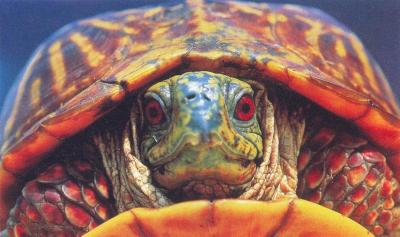|
|
Canku Ota |
|
|
(Many Paths) |
||
|
An Online Newsletter Celebrating Native America |
||
|
June 16, 2001 - Issue 38 |
||
|
|
||
|
The Young Man and the Box Turtle |
||
|
by Richard L. Slater |
||
|
This is a true story. I have added it to the story bag I made for my grandchildren. It pleases me to share it. |
 One day while
working the young man became paralyzed in the right leg. He returned home that evening and told his wife what had
happened and they decided to go to the doctor the next day. One day while
working the young man became paralyzed in the right leg. He returned home that evening and told his wife what had
happened and they decided to go to the doctor the next day.The doctor examined the young man and could find nothing wrong with his leg, but it remained paralyzed and he was sent home. The young man was very worried because he could not work or hunt in the woods to feed his family. Two days after coming home, the young man decided to try walking and took the old road that went towards the creek east of their house. As he limped and pulled himself along, he thought about what had happened and prayed that he would get better so that he could take care of his family.  He looked ahead down the old road and saw a box turtle lying on its back in the middle of the old
dirt road. As he got closer he could see the turtle was still alive and struggling to get back on its feet. The
young man knew the turtle would die if he didn't help it. As he reached the turtle, he wondered how the animal
could have been turned over, possibly a fox or coyote. He looked for other animal tracks as he turned the turtle
over. The old road was dry and dusty. No tracks, other than the print of the turtle shell were visible in the dust.
He turned the turtle onto its feet and as the young man stood looking at the turtle it started crawling towards
him. The turtle stopped, put one of its front feet on him and then turned and headed south into the woods. He looked ahead down the old road and saw a box turtle lying on its back in the middle of the old
dirt road. As he got closer he could see the turtle was still alive and struggling to get back on its feet. The
young man knew the turtle would die if he didn't help it. As he reached the turtle, he wondered how the animal
could have been turned over, possibly a fox or coyote. He looked for other animal tracks as he turned the turtle
over. The old road was dry and dusty. No tracks, other than the print of the turtle shell were visible in the dust.
He turned the turtle onto its feet and as the young man stood looking at the turtle it started crawling towards
him. The turtle stopped, put one of its front feet on him and then turned and headed south into the woods.The young man continued walking east to the creek and then turned back for home. When he came to the spot where he helped the turtle, he stopped to see if the turtle was still close to the road and checked the road for any tracks that he might have missed. There were no tracks other than his footprints in the dust of the old road bed.  He looked for the turtle south into the woods but didn't find it. He looked for the turtle south into the woods but didn't find it.Each day the young man walked the old road to look for the turtle. Fall turned to Winter and by Spring the young mans leg had healed. Thoughts of the road, the Box Turtle and the woods were put away for many years. Many years later the old man passed the place where he and his family once lived and he remembered the road, the Box Turtle and the woods, south of the road. Finally, he understood what had happened that day along the old road so many years ago. My children, at times during your life you will be given the opportunity to do good. Don't let those gifts get away. The good you do will be given back to you many times over. |
|
|
|
About our writer:
|

 Box turtles
of the genus Terrapene only occur in North America. The name Terrapene is appropriately derived from a native American
(Algonquian) word for turtle. In the United States, two separate species groups are recognized: the common box
turtle group (carolina) and the ornate group (ornata).
Box turtles
of the genus Terrapene only occur in North America. The name Terrapene is appropriately derived from a native American
(Algonquian) word for turtle. In the United States, two separate species groups are recognized: the common box
turtle group (carolina) and the ornate group (ornata). Box turtles appear to be long-lived. One Three-Toed Box Turtle apparently lived 130 years at an
Eastern zoo. Another was found in 1931 with a nearly worn-away date of 1809 carved into its shell!
Box turtles appear to be long-lived. One Three-Toed Box Turtle apparently lived 130 years at an
Eastern zoo. Another was found in 1931 with a nearly worn-away date of 1809 carved into its shell!